
In vitro studies are performed with microorganisms, cells, or biological molecules outside their normal biological context. Colloquially called "test-tube experiments", these studies in biology and its subdisciplines are traditionally done in labware such as test tubes, flasks, Petri dishes, and microtiter plates. Studies conducted using components of an organism that have been isolated from their usual biological surroundings permit a more detailed or more convenient analysis than can be done with whole organisms; however, results obtained from in vitro experiments may not fully or accurately predict the effects on a whole organism. In contrast to in vitro experiments, in vivo studies are those conducted in living organisms, including humans, known as clinical trials, and whole plants.

The Rutaceae is a family, commonly known as the rue or citrus family, of flowering plants, usually placed in the order Sapindales.
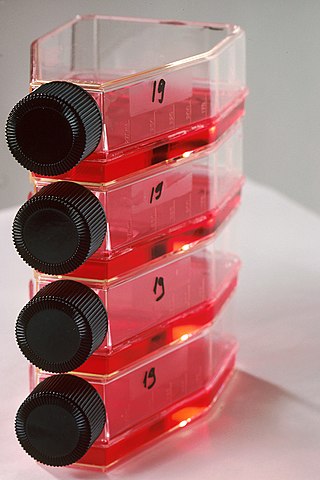
Tissue culture is the growth of tissues or cells in an artificial medium separate from the parent organism. This technique is also called micropropagation. This is typically facilitated via use of a liquid, semi-solid, or solid growth medium, such as broth or agar. Tissue culture commonly refers to the culture of animal cells and tissues, with the more specific term plant tissue culture being used for plants. The term "tissue culture" was coined by American pathologist Montrose Thomas Burrows. This is possible only in certain conditions. It also requires more attention. It can be done only in genetic labs with various chemicals.

Pilocarpine is a lactone alkaloid originally extracted from plants of the Pilocarpus genus. It is used as a medication to reduce pressure inside the eye and treat dry mouth. As an eye drop it is used to manage angle closure glaucoma until surgery can be performed, ocular hypertension, primary open angle glaucoma, and to constrict the pupil after dilation. However, due to its side effects it is no longer typically used for long-term management. Onset of effects with the drops is typically within an hour and lasts for up to a day. By mouth it is used for dry mouth as a result of Sjögren syndrome or radiation therapy.

Plant callus is a growing mass of unorganized plant parenchyma cells. In living plants, callus cells are those cells that cover a plant wound. In biological research and biotechnology callus formation is induced from plant tissue samples (explants) after surface sterilization and plating onto tissue culture medium in vitro. The culture medium is supplemented with plant growth regulators, such as auxin, cytokinin, and gibberellin, to initiate callus formation or somatic embryogenesis. Callus initiation has been described for all major groups of land plants.

Jaborandi is a Brazilian municipality of the state of São Paulo, located 491 kilometers from the state capital, São Paulo. The population is 6,946 in an area of 273 km2.
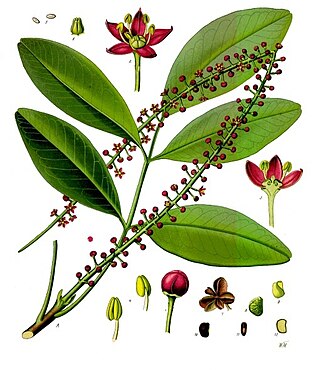
Pilocarpus is a genus of about 13 species of plants belonging to the family Rutaceae, native to the Neotropics of South America. Various species are important pharmacologically as a source of the parasympathomimetic alkaloid pilocarpine. Many of the species have the common name jaborandi.

Nepenthes truncata is a tropical pitcher plant endemic to the Philippines. It is known from the islands of Dinagat, Leyte, and Mindanao. The species grows at an elevation of 0–1500 m above sea level. Nepenthes truncata is characterised by its heart-shaped (truncate) leaves and very large pitchers, which can reach up to 40 cm in height.
In biology, a substrate is the surface on which an organism lives. A substrate can include biotic or abiotic materials and animals. For example, encrusting algae that lives on a rock can be itself a substrate for an animal that lives on top of the algae. Inert substrates are used as growing support materials in the hydroponic cultivation of plants. In biology substrates are often activated by the nanoscopic process of substrate presentation.

Brazil has great forests. Minas Gerais, Brazil's central state, larger domain is the tropical forest. Within it there are many types of plants. Separated by families this is a list of these plants:

Caatinga is a type of semi-arid tropical vegetation, and an ecoregion characterized by this vegetation in interior northeastern Brazil. The name "Caatinga" is a Tupi word meaning "white forest" or "white vegetation" . The Caatinga is a xeric shrubland and thorn forest, which consists primarily of small, thorny trees that shed their leaves seasonally. Cacti, thick-stemmed plants, thorny brush, and arid-adapted grasses make up the ground layer. Most vegetation experiences a brief burst of activity during the three-month long rainy season.
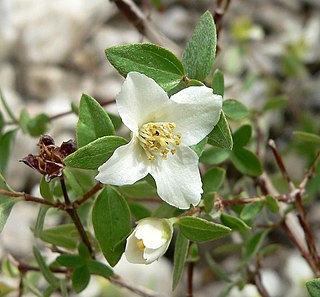
Philadelphus microphyllus is a species of Philadelphus known by the common names littleleaf mock-orange or desert syringa. It is native to northern Mexico and the southwestern quadrant of the United States as far north as Wyoming, where it grows in scrub and brush habitat in foothills and mountains, often in very rocky areas, sometimes anchoring itself in rock cracks and crevices.
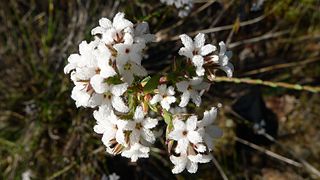
Leucopogon microphyllus is a species of flowering plant in the heath family Ericaceae and is endemic to eastern Australia. It is a bushy or spreading shrub with egg-shaped leaves, sometimes with the narrower end towards the base, and compact spikes of usually four to nine white, tube-shaped flowers.
Symphoricarpos microphyllus, the pink snowberry, is a North American species of flowering plant in the honeysuckle family. It is widespread across much of Mexico from Chihuahua to Chiapas, and found also in Guatemala, Honduras, and the US State of New Mexico.
Photoautotrophic tissue culture is defined as "micropropagation without sugar in the culture medium, in which the growth or accumulation of carbohydrates of cultures is dependent fully upon photosynthesis and inorganic nutrient uptake".

In Vitro Cellular & Developmental Biology is a peer-reviewed scientific journal covering all aspects of in vitro biology. It was originally established as In Vitro in 1965, acquiring its current name in 1983. In 1991, In Vitro Cellular & Developmental Biology – Plant was created, with the original section renaming itself In Vitro Cellular & Developmental Biology – Animal in 1993. The journals are published by Springer Science+Business Media on behalf of the Society for In Vitro Biology.
Pilocarpus jaborandi is a species of flowering plant in the family Rutaceae, native to northeast Brazil. It is a source of the drug pilocarpine.
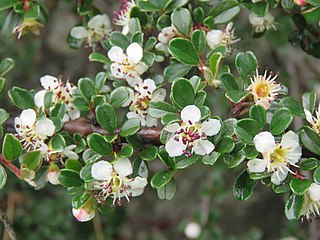
Cotoneaster microphyllus, the small-leaved cotoneaster or rockspray cotoneaster, is a species of flowering plant in the family Rosaceae. It is native to the Indian Subcontinent, Tibet, Sichuan, and Yunnan in China, and Myanmar, and it has been introduced to various locales in Europe, Australia, and the United States. A rabbit-tolerant shrub reaching 1 m (3 ft) tall but spreading to 2.5 m (8 ft), and hardy in USDA zones 5 through 7, it is recommended for rockeries and hedges. Care should be taken not to plant it where it can become invasive.

Imidazole alkaloids are a group of alkaloids whose basic structure contains the imidazole ring system.















